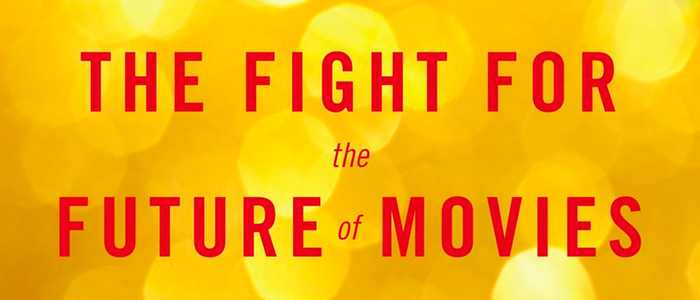‘The Big Picture’ is a Must-Read Book About Filmmaking in the 21st Century
How did the movie industry get to this point? Why have mid-budget, adult-driven films all but vanished from the multiplexes while superhero movies and franchises reign supreme? Ben Fritz answers these questions, and more, in his addictive new book The Big Picture: The Fight for the Future of Movies.
Our The Big Picture review delves into Ben Fritz’s highly entertaining book about Hollywood in the 21st century, and highlights segments about Disney, Marvel Studios, Netflix, Sony and more.
In a slightly-gossipy yet never exploitative style, Fritz combs through the data of the last decade, picking apart both behind-the-scenes shenanigans and emails gleaned from the infamous Sony hack. Fritz examines the fall of Sony as a major box office player; the rise of Marvel studios; the death of mid-budget films; the growth of Netflix original programming and much, much more. If there’s one recurring element in the book, it’s Sony, and its former chairperson Amy Pascal. One gets the sense that Pascal is one of the rare Hollywood execs who actually loves movies as an art form, and not just as money-making machines. The way Fritz tells it, it was perhaps this undying devotion to small, adult-driven drama that ultimately lead to Pascal’s Sony downfall.
If you’re a film fan, The Big Picture is a must-read. It’s an informative, entertaining, often maddening look at how the film industry ended up where it is today – for better or worse. Below, I’ve highlighted some key revelations from the book, but they only scratch the surface. For the full story, pick up Fritz’s book. I guarantee you’ll likely power through it in one sitting, unable to put it down.
Stolen Material
First thing’s first: Fritz is clear out of the gate that a lot of the research he gathered for the book was taken from the hacked, AKA stolen, Sony emails. In 2014, a hacker group leaked a wealth of Sony material online, including personal emails, salary info and then-unreleased movies. The hackers were allegedly from North Korea, spurned on to their actions by the impending release of Sony’s North Korean-themed dark comedy The Interview (although there are some who think the hack actually came internally and used North Korea as a scapegoat).
There is an ethical question here, and I could certainly understand someone not even wanting to delve into the book for these reasons. For his part, Fritz is open about all of this. “This book is based, in part, on stolen material. I won’t make any bones about it,” the author says in the introduction. “Nevertheless, it’s an undeniable fact that much great journalism has used stolen material as its source.” As an example of this, Fritz cites the famous Pentagon Papers (recently chronicled in Steven Spielberg’s The Post).
“Whatever your views,” Fritz writes, “I hope you’ll agree that what you’re about to read is not exploitative.”
For what it’s worth, I do think Fritz does a good job of keeping things on the level. He never dives into personal issues (unlike, say, the similar Hollywood history book Easy Riders, Raging Bulls), and sticks strictly to the business side of things.
The Fall of Sony
Since Fritz used the Sony hack as a springboard, Sony takes up a larch chunk of the first part of the book. Most of this focuses on Amy Pascal’s (failed) attempts to compete with Disney and Marvel.
As Fritz details, while other studios got into the franchise game, Sony essentially relied on three major franchises: James Bond, Men In Black and Spider-Man. Unfortunately for Sony, all three came with “baggage”. Sony didn’t actually own the Bond franchise – MGM did, so while the Bond film Skyfall made $1.1 billion worldwide, Sony only made about $57 million from the film.
Men In Black 3, Sony’s third biggest hit of 2012, grossed $624 million worldwide. But that wasn’t enough of a profit, since Sony had to pay star Will Smith and executive producer Steven Spielberg $90 million in gross points.
As for Spidey, Sony’s reboot The Amazing Spider-Man earned “about $110 million on $758 million of worldwide ticket sales,” which was “[l]ess than half the profits of 2007’s Spider-Man 3.”
In Sony’s desperate attempt to launch new franchises, they bought rights to titles like Barbie, the Fifth Wave series and Stephen King’s Dark Tower series. They also considered combining the Men in Black and 21 Jump Street franchises (an idea that seems to be dead now). On top of that, they tried to launch a remake of Cleopatra, a third Ghostbusters, Bad Boys 4, a new He-Man film and a film based on the video game Uncharted. Almost none of these films have come to be.
The Rise of Superhero Films and Marvel Studios
Sony’s plan to reboot Spider-Man didn’t go as planned. The Amazing Spider-Man didn’t perform as well as the studio had hoped, and The Amazing Spider-Man 2 fared even worse. One interesting tidbit Fritz reveals while discussing the Spider-Man series: after Amazing Spider-Man 2 failed to live up to expectations, Amy Pascal actually reached out to former Spider-Man director Sam Raimi and asked if he’d be interested coming back to revive the franchise. As we all know by now, Raimi did not return, and a deal between Marvel Studios and Sony enabled Spidey to be reborn into the MCU (although Pascal apparently threw a sandwich at Marvel Studios President Kevin Feige when he first proposed the idea).
Feige and Marvel “disliked” what Sony had been doing with Spider-Man. “[Feige] thought restarting with The Amazing Spider-Man, rather than moving on from Raimi’s mistakes in Spider-Man 3, had been a mistake,” Fritz writes, and quotes Feige as saying:
“In a million years I would never advocate rebooting…Iron Man; To me it’s James Bond and we can keep telling new stories for decades even with different actors.”
The not-so-friendly relationship between Sony and Marvel gets some attention in this segment. Specifically, Sony’s major blunder that cost them the entire MCU. Back when Sony first went to Marvel to snag the Spider-Man rights, Marvel’s new chief, Ike Perlmutter, offered up an even sweeter deal. Sony could have the rights to virtually every Marvel character, including Iron Man, Thor, Ant-Man, and Black Panther, for a cool $25 million. Sony’s reply? “Thanks, but no thanks.”
Fritz also tracks the rise of Marvel Studios from an office above a Mercedes dealership in Beverly Hills to a major Hollywood player. The author also reveals the reasoning behind launching the MCU with Iron Man: toys! As Fritz writes:
“To decide which film to make first, Marvel convened focus groups. But they weren’t convened in order to ask a random cross-section of people which story lines and characters they would most like to see onscreen. Instead, Marvel brought together groups of children, showed them pictures of its superheroes, and described their abilities and weapons. Then they asked the kids which ones they would most like to play with a toy. The overwhelming answer, to the surprise of Many at Marvel, was Iron Man.”
Further along, Fritz reveals what you might have long suspected about Marvel: they like to seek out directors they know they can control. As the author puts it, this was one of the reasons Marvel hired Jon Favreau to helm Iron Man:
“Favreau wasn’t particularly powerful in Hollywood, meaning that if battles over costs or creative choices arose, and if they needed to push him around, they could.”
“We would never have a final cut director,” David Maisel, then president and chief operating officer of Marvel Studios, is quoted as saying. “Our movies were not the director’s fiefdom.”
Maisel was one of the key-figures who saw the potential in a cinematic universe. “One of the best businesses in movies is sequels because you can better predict the revenue and the costs,” he’s quoted as saying. “I knew by interspersing our characters, I was making every movie a quasi-sequel.”
The End of Movie Stars
There was a time when the movie star reigned supreme. Audiences didn’t so much flock to the multiplexes for a film’s subject – they went to see the star. They went to see Tom Cruise, or Sandra Bullock, or Will Smith. These days, that’s not the case. Star power has waned.
“What happened?” Fritz writes. “Audiences’ loyalties shifted. Not to other stars, but to franchises. Today, no person has the box-office track record that [Tom] Cruise once did, and it’s hard to imagine that anyone will again. But Marvel Studios does. Harry Potter does. Fast & Furious does.”
As the author puts it, “Moviegoers looking for consistent, predictable satisfaction they used to get from their favorite stars now turn to cinematic universes.”
From here, The Big Picture goes on to talk about how two of Sony’s biggest stars, Will Smith and Adam Sandler, began to lose their luster. Smith and Sandler once commanded box office gold, but the 21st century put a stop to that.
One of the prime examples of this is Smith’s sci-fi epic After Earth, which was a box office failure for Sony. Smith had extremely lofty ideas for the film. He didn’t just want to turn After Earth into a movie – he wanted “a live-action television show, an animated series, webisodes and mobisodes, a video game, consumer products, theme-park attractions, documentaries, comic books, an ‘in-school education program in partnership with NASA,’ and ‘cologne, perfume, toiletries, etc.’”
Needless to say, none of this happened.
There’s one final indignity in the chapter dealing with Smith: the former box office king really wanted to star in Passengers, but Sony preferred newly-minted blockbuster champ Chris Pratt instead. Perhaps Smith got the last laugh, though – he went to Netflix for a big payday with Bright, and Passengers flopped.
Continue Reading The Big Picture Review >>
The post ‘The Big Picture’ is a Must-Read Book About Filmmaking in the 21st Century appeared first on /Film.
from /Film http://ift.tt/2Hh925Y





No comments: